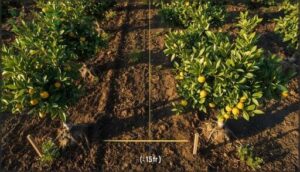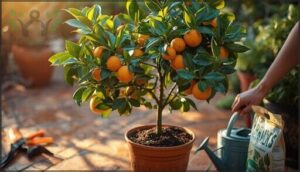This site is supported by our readers. We may earn a commission, at no cost to you, if you purchase through links.
Most citrus trees can thrive for decades in the right conditions, producing hundreds of pounds of fruit each year while asking surprisingly little in return. That’s the beauty of citrus gardening for beginners—these plants reward your efforts with fragrant blossoms, glossy evergreen leaves, and fresh fruit that tastes nothing like the supermarket version.
Whether you’re working with a sunny backyard or a bright balcony, growing your own lemons, limes, or oranges doesn’t require a green thumb or years of experience. You just need to understand a few key principles about sunlight, soil, and watering to set yourself up for success and enjoy homegrown citrus within a year or two.
Table Of Contents
Key Takeaways
- Citrus trees reward new gardeners with minimal effort, producing hundreds of pounds of fruit annually while staying evergreen year-round, maintaining glossy leaves that improve air quality and release calming fragrances from compounds like limonene.
- Beginner-friendly varieties like Meyer Lemon and Satsuma Mandarin tolerate mistakes and deliver reliable harvests within 3-5 years when grafted, while thriving in USDA zones 9-11 or containers that allow microclimate control in cooler regions.
- Success depends on establishing proper fundamentals at planting—6-8 hours of direct sunlight daily, well-drained soil with pH 5.8-6.5, deep watering every 1-2 weeks for mature trees, and nitrogen-rich fertilizer applied every 1-2 months during growing season.
- Early pest detection through sticky traps and visual checks prevents major damage from aphids, leafminers, and scale insects, while winter protection strategies like mulching, frost covers, or moving containers indoors before temperatures hit 2°C ensure survival in borderline climates.
Benefits of Growing Citrus at Home
Growing citrus trees at home offers more than just the promise of fresh fruit—it’s an investment that pays dividends in ways you mightn’t expect. From the moment you plant your tree, you’ll notice benefits that extend beyond your kitchen.
Let’s look at three compelling reasons why citrus trees deserve a spot in your garden or patio.
Year-Round Greenery and Fragrance
One of citrus gardening’s greatest rewards is the steady beauty these fragrant trees bring to your space. Unlike deciduous plants that drop leaves seasonally, citrus trees remain vibrant year-round, offering benefits that touch both sight and scent.
Citrus trees provide a range of advantages, including:
- Evergreen foliage care maintains glossy leaves through winter, sustaining photosynthesis and visual appeal
- Seasonal bloom cycles produce fragrant flowers primarily in spring, with sporadic blossoms throughout favorable months
- Continuous fragrance from compounds like limonene creates calming sensory experiences
- Air quality impact improves as leaves absorb carbon dioxide and capture airborne particles consistently
- Aesthetic sensory benefits combine lush greenery with natural aroma, reducing stress in indoor citrus trees and outdoor gardens alike.
To get the most fruit, make sure your tree gets at least five hours of direct sunlight.
Fresh, Homegrown Citrus Fruit
Beyond beauty, your home citrus trees deliver nutrient-rich harvests you’ll notice right away. Fresh citrus fruit picked at peak ripeness offers enhanced flavor profiles and higher vitamin C levels—a medium orange provides your entire daily requirement. You control the organic growing practices, avoiding pesticides while enjoying authentic taste. Citrus fruits also provide anti-inflammatory benefits that contribute to overall health.
Here’s what homegrown citrus brings to your table:
| Nutritional Benefit | Home Harvest Advantage | Practical Use |
|---|---|---|
| Vitamin C concentration | 75-90 mg per medium fruit | Immune support, skin health |
| Fiber content | 2-4 grams per cup | Digestive function, cholesterol reduction |
| Bioactive compounds | Higher antioxidant levels when fresh-picked | Chronic disease prevention |
| Calorie efficiency | 45-60 calories per fruit | Nutrient density without excess sugar |
Ripeness indicators like color intensity and slight softness signal ideal harvest timing. Storage methods extend enjoyment—refrigerate whole fruit for three to four weeks, or freeze juice and zest for later culinary projects.
Sustainability and Cost Savings
Your citrus garden yields economic benefits beyond flavor. You’ll reduce your carbon footprint by eliminating transportation emissions while mature trees produce up to 200 pounds annually, cutting grocery costs by 30%.
Growing citrus at home cuts grocery costs by 30% while eliminating transportation emissions and producing up to 200 pounds of fruit annually
Water conservation improves through drought-resistant established trees, and organic practices with compost-based fertilizer eliminate synthetic chemicals.
Waste reduction happens naturally—you’re composting peels and avoiding packaging while supporting pollinators and improving local air quality through home gardening.
Choosing The Right Citrus Tree
Choosing the right citrus tree sets the foundation for years of healthy growth and abundant harvests. Your decision should balance practical factors like your climate and available space with personal preferences, such as the type of fruit you’d most enjoy eating.
Let’s explore the key considerations that will help you pick the perfect tree for your home garden.
Popular Beginner Varieties
When you’re just starting out with citrus trees, choosing the right variety makes all the difference. You want plants that forgive beginner mistakes, produce reliably, and don’t demand constant attention. Here are four excellent options that deliver both delicious citrus fruit and straightforward care:
- Meyer Lemon – Sweeter than standard limes or typical lemons, these everbearing trees produce fragrant blossoms and fruit multiple times yearly, reaching 6–10 feet in containers
- Bearss Lime – A top performer yielding tart, seedless limes perfect for drinks and cooking
- Calamansi – Small, tangy oranges with considerable disease resistance; calamansi uses include beverages and preserves
- Satsuma Mandarin – Cold-tolerant, seedless, easy-to-peel fruit that ripens early for simple kumquat care-level simplicity
Climate and Hardiness Zones
Before you fall in love with a particular tree, check your USDA hardiness zone—it determines which citrus can survive your winters. Most citrus thrives in zones 9–11, where temperatures rarely dip below -3.3°C (26°F).
In zone 8 or cooler climates, you’ll need frost protection strategies like coverings and microclimate creation near warm walls. Cold-hardy satsumas tolerate brief cold snaps down to -6.7°C (20°F), while heat tolerance peaks around 38–43°C before sunburn risk climbs.
Fruit Preference and Disease Resistance
While taste matters, disease resistance can mean the difference between thriving trees and years of frustration. Over 70% of citrus consumers prioritize taste and color, but home gardeners also need varieties that fight off bacterial canker, HLB, and viral diseases.
Consider these factors:
- Taste vs. Resistance – Sweet Meyer lemons taste great but lack strong disease defenses.
- Consumer Demand Trends – Mandarins and tangerines now outsell oranges in fresh markets.
- Breeding Innovations – New HLB-tolerant varieties like NuCitrus promise normal yields under disease pressure.
- Organic Options – Locally sourced, disease-resistant cultivars reduce chemical treatments.
Genetic engineering and Australian citrus relatives offer hope, combining flavor with pest and disease resilience.
Space and Container Considerations
Before you commit to a citrus tree, think about your available square footage and whether you’ll grow in the ground or in containers. Compact lemon and lime trees need at least 10 x 10 feet in-ground for healthy root development, while dwarf varieties thrive in 15-gallon pots with proper drainage importance. Container material—fabric, clay, or plastic—affects root system health and yield correlation.
| Planting Type | Minimum Space/Size |
|---|---|
| In-Ground Standard | 12–25 feet apart |
| In-Ground Dwarf | 6–12 feet apart |
| Container (Semi-Dwarf) | 15–25 gallon pot |
Choosing the right potting soil and container gardening setup maximizes space impact and fosters strong root systems, especially for growing in containers.
Preparing Your Citrus Growing Site
Before you plant your citrus tree, you’ll need to set it up for success by choosing the right spot and preparing the growing environment. Think of this stage as laying the foundation—your tree’s long-term health depends on getting the location, soil, and container setup right from the start.
Let’s walk through the key factors to keep in mind so your citrus tree can thrive for years to come.
Selecting The Optimal Location
Choosing the right planting site can make or break your citrus tree’s success. You’ll need at least eight hours of direct sunlight exposure daily, ideally on the south side of your home where microclimate benefits include extra warmth.
Space trees 6 to 8 feet from buildings, following proper spacing guidelines. Wind protection from fences or walls reduces stress, while terrain considerations like planting on upper slopes help avoid frost pockets.
Soil Quality and Drainage Requirements
Your citrus tree’s roots need well-drained soil with a pH between 5.8 and 6.5 to absorb nutrients efficiently. Poor drainage drowns roots and invites disease, so aim for at least 24 inches of permeable topsoil. Sandy soils work beautifully, while clay needs amendment with organic matter to improve structure.
Test your soil’s salinity tolerance too—citrus struggles when salinity exceeds 1.4 dS/m, reducing growth and fruit production considerably.
Choosing The Right Potting Mix for Containers
Your potting soil sets the foundation for thriving roots and healthy fruit production. Container gardening demands a specialized mix that balances drainage needs with nutrient density—regular garden soil won’t cut it.
For best root health and pH balance, combine these mix components:
- Five parts fine bark for drainage and aeration
- One part perlite to prevent compaction
- One part potting soil enriched with slow-release fertilizer
This well-draining soil maintains the 5.8–6.5 pH range citrus craves.
Planting Your Citrus Tree
Once you’ve chosen your citrus tree and prepared the site, it’s time to get your hands dirty. Planting correctly from the start gives your tree the best chance to develop strong roots and thrive for years to come.
Let’s walk through the key decisions and techniques that’ll set your citrus up for success.
In-Ground Vs. Container Planting
You’ve got two paths for citrus tree planting: in-ground or container gardening. In-ground offers expansive root space and better water retention, supporting larger root systems and vigorous growth.
Containers provide portability and microclimate control, letting you adjust soil composition and drainage precisely. Container gardening works beautifully for limited spaces, though you’ll water more frequently since potting mix dries faster than garden soil.
Proper Planting Depth and Spacing
Once you’ve chosen your planting site, proper depth and spacing become the foundation for healthy root systems. Position the root ball so its top sits level with the soil line—never bury the graft union.
Spacing citrus tree planting at least 15 feet apart delivers benefits like better air circulation and yield optimization, while preventing soil compaction that restricts root development.
Initial Watering and Mulching
After planting, give your tree 2 to 3 thorough waterings within the first week to kickstart root establishment. Then water once or twice weekly, delivering 8–10.5 gallons each time to maintain soil moisture balance in well-drained soil.
Apply 2–4 inches of organic mulch—pine bark works beautifully—around the root system, keeping it away from the trunk for pest suppression and consistent moisture retention.
Essential Citrus Tree Care Tips
Once your citrus tree is in the ground or settled into its container, the real work begins. Proper care keeps your tree healthy, encourages fruit production, and helps it thrive for decades.
Let’s walk through the key practices that’ll set you up for success.
Sunlight and Watering Schedules
Your citrus tree thrives when light intensity and watering depth work in harmony. Provide 6 to 8 hours of direct sunlight daily, adjusting seasonal placement to maintain consistently moist soil without waterlogging.
Water newly planted trees every three days during summer heat, tapering as they establish. Mature trees need deep watering every one to two weeks, ensuring proper soil moisture balance and excellent drought tolerance over time.
Fertilizer Needs and Feeding Frequency
During active growth periods, your citrus tree demands nitrogen-rich nutrition to prevent nutrient deficiencies and support vigorous foliage. Balanced citrus fertilizer containing essential nutrients meets these needs effectively.
- Apply fertilizer every 1 to 2 months from early spring through mid-summer
- Use nitrogen-focused ratios like 7-3-3 or 12-6-6 for best results
- Include micronutrients such as zinc, iron, and magnesium
- Spread fertilizer evenly under the canopy, avoiding the trunk
- Water thoroughly after each application to promote absorption
Pruning for Health and Shape
Late winter to early spring offers the perfect window for pruning your citrus tree, helping you maintain its shape while preventing disease. Use sharp, sterilized pruning shears to remove dead or crossing branches, improving air circulation and fruit yield. Tree shaping during this period promotes best growth without attracting summer pests.
Sterilize your tools between cuts—tool sterilization prevents spreading infections and keeps your tree healthy and productive.
Protecting Citrus Trees From Pests and Weather
Your citrus tree’s biggest challenges come from tiny pests and sudden weather changes, but you can stay one step ahead with the right knowledge.
Catching problems early makes all the difference between a thriving tree and one that struggles to produce fruit.
Let’s walk through the most common threats you’ll face and exactly how to protect your tree year-round.
Common Pests and Diseases
Your citrus trees face several threats that can reduce harvest quality and tree vigor. Aphids, citrus leafminers, and scale insects are the most common pests you’ll encounter. Leafminer damage appears as winding trails in leaves, reducing photosynthesis by up to 67% in young trees.
Fungal infections thrive in humid conditions, while HLB impact has devastated commercial groves, making disease control essential for home gardeners too.
Preventing and Treating Problems
Think your citrus tree can handle anything? Even the hardiest varieties need strong pest management and disease prevention to truly thrive.
Get ahead with vigilant early detection—using sticky traps, organic pest control, and regular visual checks. Stay vigilant for nutrient deficiency and tailor your water management.
With smart, steady pest and disease control, your grove stands a much better chance.
Winter Protection Strategies
When cold weather threatens, protecting citrus trees becomes your top priority—especially in cold climate regions where frost protection can mean the difference between a thriving harvest and a damaged tree.
Here are three proven winter protection strategies:
- Insulate the roots with mulching techniques like straw layers that boost soil warmth by up to 3°C near the base
- Active heating using frost covers or outdoor-rated bulbs raises temperatures by 2–4°C during freezing nights
- Moving containers indoors before temperatures hit 2°C ensures 95% survival rates
Timing implementation matters—act when forecasts predict lows below 2°C, considering your local climate considerations for best results.
Harvesting and Enjoying Your Citrus Fruit
After all your hard work tending to your citrus tree, the reward comes when you finally get to harvest those beautiful fruits. Knowing when your citrus is ready to pick, how to harvest it properly, and what to do with it afterward will help you get the most out of your homegrown crop.
Let’s look at the key steps to harvesting and enjoying your fresh citrus.
Signs of Ripeness and Harvest Timing
Knowing when to harvest makes all the difference in fruit flavor and juice content. Watch for color development—oranges turn deep orange, lemons bright yellow—though varieties like Emerald Green satsumas stay green when ripe. Feel for slight give under gentle pressure, sniff for strong aroma intensity near the stem, and compare weight between fruits.
Harvest seasons vary: oranges ripen late fall to early spring, limes in late summer. Remember, citrus fruit harvesting requires on-tree ripeness since fruit ripening stops after picking.
Harvesting Techniques
Once your fruit’s ripe, use sharp pruning shears or clippers for manual harvesting—the classic “twist, jerk, and pull” motion works well. For tender-skinned lemons and tangerines, clip the stem just above the button to prevent tearing.
Extension poles help you reach high branches safely without ladders, reducing fall risks.
Handle fruit gently to avoid bruises, and harvest when conditions are dry for best post-harvest handling results.
Storing and Using Fresh Citrus
After harvesting, proper storage maximizes your citrus’s shelf life and nutritional retention. Ideal storage extends freshness considerably—refrigerate whole fruit for three to four weeks instead of leaving it on the counter for less than seven days. For household utilization and food safety, store citrus in mesh bags or loosely in your crisper drawer to prevent mold:
- Use refrigerated juice within two to three days for best flavor
- Freeze zest for months of culinary uses
- Keep whole fruit at 40–50°F with good airflow
- Avoid overcrowding to prevent bruising and spoilage
- Wax-coated citrus fruits last longer when chilled properly
Frequently Asked Questions (FAQs)
How long until my citrus tree bears fruit?
Grafting effects dramatically shorten the wait—grafted trees generally bear fruit within 3 to 5 years, while seedling timelines stretch to 7–10 years, with variety influence and climate impact affecting fruit production substantially.
Can citrus trees be grown indoors successfully?
Yes, you can successfully grow citrus trees indoors, though indoor fruiting rates are lower than outdoors. Light supplementation needs, humidity control importance, and proper pollination challenges indoors affect your container citrus growing success.
What causes citrus leaves to curl or brown?
Think your citrus tree’s leaf curling is a mystery? It’s not. Moisture stress, pest infestation, nutrient deficiencies, overwatering issues, and chemical damage all contribute to leaf discoloration, demanding proper citrus tree care.
Do citrus trees need cross-pollination to fruit?
Most citrus trees are self-pollinating and will produce fruit on their own, but cross-pollination with bees often boosts your yield and can improve fruit quality, making it worth encouraging pollinators.
How do I revive a struggling citrus tree?
When your tree shows leaf discoloration or decline, start with proper water management and address nutrient deficiencies.
Inspect for pests, adjust fertilizer, improve soil drainage, and prune dead branches to encourage recovery.
Conclusion
Picture yourself stepping outside on a quiet morning, plucking a sun-warmed lemon from your own tree, and tasting citrus that never saw a shipping container. That’s the reward waiting for you.
Citrus gardening for beginners isn’t about flawlessness—it’s about patience, consistency, and learning as you grow. Give your tree what it needs, protect it when weather turns harsh, and you’ll enjoy fresh fruit for decades. Your first harvest will make every effort worthwhile.
- https://citrusindustry.net/2021/12/21/floridas-top-rootstocks-and-varieties/
- https://www.fourwindsgrowers.com/a/blog/3-easiest-citrus-trees-to-grow
- https://growingfruit.org/t/beginner-citrus/69379
- https://veritablevegetable.com/citrus-guide/
- https://crec.ifas.ufl.edu/home-citrus/selecting-a-citrus-tree/












